Common Shelduck Tadorna tadorna
Order: Anseriformes. Family: Anatidae
Description
58–67 cm. The common shelduck resembles a small short-necked goose in size and shape. It is a striking bird, with a reddish-pink bill, pink feet, a white body with chestnut patches and a black belly, and a dark green head and neck. The wing coverts are white, the primary remiges black, and the secondaries green (only showing in flight) and chestnut. The underwings are almost entirely white. Sexes are similar, but the female is smaller, with some white facial markings, while the male is particularly crisply colored in the breeding season, his bill bright red and bearing a prominent knob at the forehead.
Ducklings are white, with black cap, hindneck and wing and back patches. Juveniles are similarly colored, greyish above and mostly white below, but already have the adult's wing pattern.
Distribution
Introduced to South Africa. Breeds in coastal NW Europe (occasionally N to Iceland) and scattered Mediterranean sites (formerly S to Algeria) E through W & C Asia to NE China (Inner Mongolia), and S to Jordan (irregular breeder), Iran and Afghanistan; winters S to N Africa (very locally W Africa), Middle East, Pakistan, N India, Bhutan, Bangladesh and S China.
Habitat
The Common Shelduck frequents estuaries and mudflats, shores of salt and brackish water lakes, and usually occurs only in salt water, mainly in Europe.
Diet
The Common Shelduck feeds on aquatic invertebrates such as molluscs, insects and crustaceans. In NW Europe, it takes salt-water snails (Hydrobia ulvae). But small fish, worms and plant materials are taken too.
It forages in shallow water by upending and head-dipping, and mostly by digging, scything and dabbling on mudflats.
Breeding
The breeding season starts in April/June. They can breed in isolated pairs or in small groups. The female chooses the nest-site, accompanied by the male. They nest in cavities in hollow trees or in burrows dug by rabbits. The nest is made with grass and moss, and is lined with down. The female lays 8-10 creamy-white eggs. The incubation lasts 29-31 days by the female alone, while the male remains in the close vicinity of the nest. The chicks leave the nest very soon after hatching, and sometime have to walk some distance to reach the water. Both parents lead them to the feeding areas and defend them against predators. The chicks of a colony often form crèches where some adults guard them. They fledge about 45-50 days after hatching, and are independent as soon as they can fly.
Africa Wild Bird Book
- Flutterby
- Posts: 44029
- Joined: Sat May 19, 2012 12:28 pm
- Country: South Africa
- Location: Gauteng, South Africa
- Contact:
South African Shelduck
103. South African Shelduck Tadorna cana (Kopereend)
Order: Anseriformes. Family: Anatidae
Description
63 cm. A large, russet duck with a black bill and legs. In flight both sexes show white forewing.
Adult male: Has a grey head and neck, and a russet and brown body. The folded wing has a white panel (coverts), a green panel (secondaries) and black primaries. Eyes are dark brown, and the bill, legs and feet are black.
Adult female: Similar to the male, but with a variable amount of white on the face and neck. The pattern of white and grey on the face and neck also varies.
Juveniles are like the males but duller, and the head is suffused with brown.
Similar species: Female differs from White-faced Duck in grey (not black) head and neck.
Distribution
Endemic to southern Africa where it is found mainly in Western Cape, Northern Cape, Free State, North West Province, Gauteng, Namibia, south-eastern Botswana and southern KwaZulu-Natal.
Habitat
Freshwater lakes and dams in drier or semi-arid areas.
Diet
During the breeding season in South Africa its diet consists entirely of vegetable matter, such as seeds, leaves and roots of grasses, reeds and pondweed, as well as filamentous algae. During the non-breeding season the species is omnivorous, feeding on both animals (mainly crustaceans, brachiopods and insect larvae and pupae) and plants.
Breeding
Forms breeding pairs, which are territorial in the breeding season. Pair bonds are thought to persist over more than one season. The nest is made by the female in a pre-existing cavity in the ground, most typically in an Aardvark burrow, but can also be in holes of Springhares and Porcupines. They have also been known to nest among rocks and in a haystack. Other than helping to hide away the nest (especially useful because the the sparse vegetation surrounding the water bodies they like inhabiting), nesting in burrows also helps to avoid the high temperatures encountered in the semi-arid conditions above.
Breeding season is from March to December, peaking from June to September. The female lays 6-15 eggs (usually 7-11) and the incubation period is for about 30 days. Only the female incubates the eggs while the male protects the territory by hissing loudly to inform the female of potential predators. Both parents care for the young and drive off any animals that vaguely look threatening - even herons and cormorants. Young are able to fly by 70 days old and they leave the adults from 90-120 days old.
Call
Loud nasal honk by male, slightly higher pitched hank by female, often as duet in flight.
Listen to Bird Call.
Status
Endemic. Common resident and local nomad; widespread movements recorded.
Order: Anseriformes. Family: Anatidae
Description
63 cm. A large, russet duck with a black bill and legs. In flight both sexes show white forewing.
Adult male: Has a grey head and neck, and a russet and brown body. The folded wing has a white panel (coverts), a green panel (secondaries) and black primaries. Eyes are dark brown, and the bill, legs and feet are black.
Adult female: Similar to the male, but with a variable amount of white on the face and neck. The pattern of white and grey on the face and neck also varies.
Juveniles are like the males but duller, and the head is suffused with brown.
Similar species: Female differs from White-faced Duck in grey (not black) head and neck.
Distribution
Endemic to southern Africa where it is found mainly in Western Cape, Northern Cape, Free State, North West Province, Gauteng, Namibia, south-eastern Botswana and southern KwaZulu-Natal.
Habitat
Freshwater lakes and dams in drier or semi-arid areas.
Diet
During the breeding season in South Africa its diet consists entirely of vegetable matter, such as seeds, leaves and roots of grasses, reeds and pondweed, as well as filamentous algae. During the non-breeding season the species is omnivorous, feeding on both animals (mainly crustaceans, brachiopods and insect larvae and pupae) and plants.
Breeding
Forms breeding pairs, which are territorial in the breeding season. Pair bonds are thought to persist over more than one season. The nest is made by the female in a pre-existing cavity in the ground, most typically in an Aardvark burrow, but can also be in holes of Springhares and Porcupines. They have also been known to nest among rocks and in a haystack. Other than helping to hide away the nest (especially useful because the the sparse vegetation surrounding the water bodies they like inhabiting), nesting in burrows also helps to avoid the high temperatures encountered in the semi-arid conditions above.
Breeding season is from March to December, peaking from June to September. The female lays 6-15 eggs (usually 7-11) and the incubation period is for about 30 days. Only the female incubates the eggs while the male protects the territory by hissing loudly to inform the female of potential predators. Both parents care for the young and drive off any animals that vaguely look threatening - even herons and cormorants. Young are able to fly by 70 days old and they leave the adults from 90-120 days old.
Call
Loud nasal honk by male, slightly higher pitched hank by female, often as duet in flight.
Listen to Bird Call.
Status
Endemic. Common resident and local nomad; widespread movements recorded.
- Flutterby
- Posts: 44029
- Joined: Sat May 19, 2012 12:28 pm
- Country: South Africa
- Location: Gauteng, South Africa
- Contact:
South African Shelduck Photos
103. South African Shelduck Tadorna cana
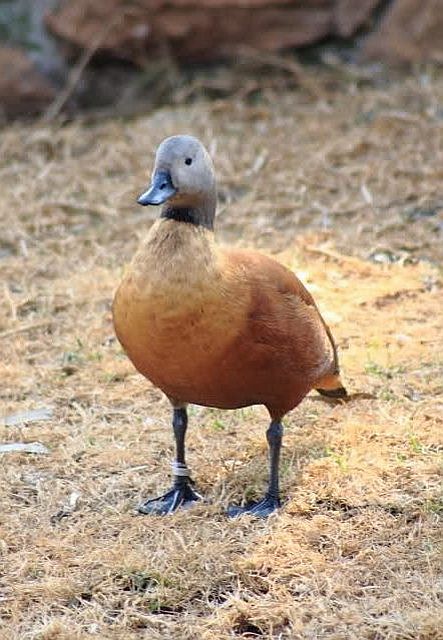 © Flutterby
© Flutterby
Male
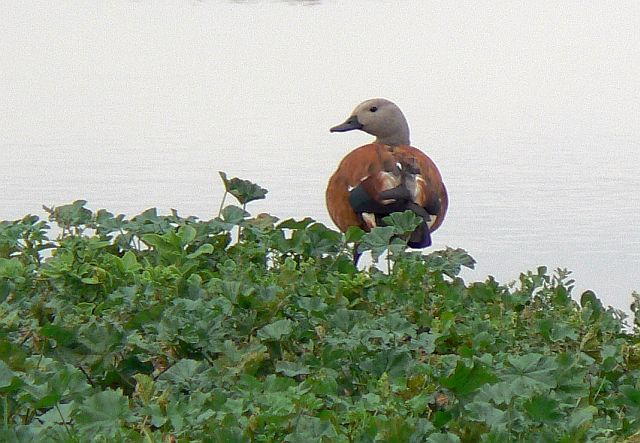 © Toko
© Toko
Male. Addo Elephant National Park
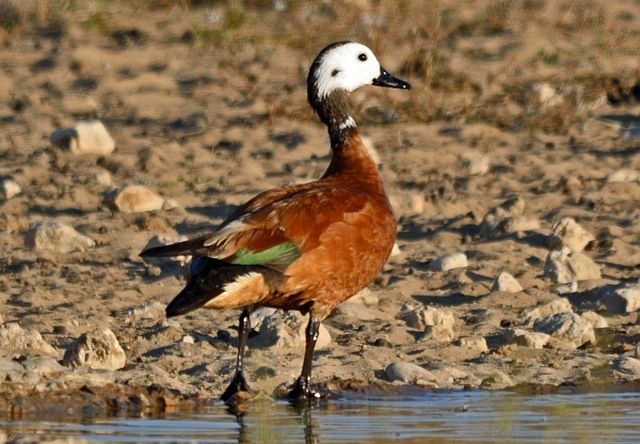 © BluTuna
© BluTuna
Female
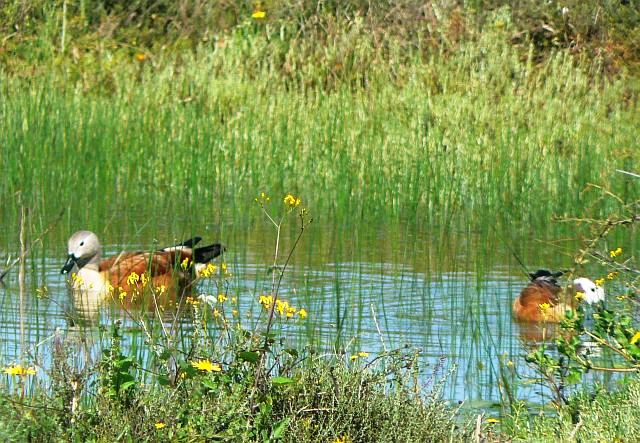 © Toko
© Toko
Male & female. Addo Elephant National Park
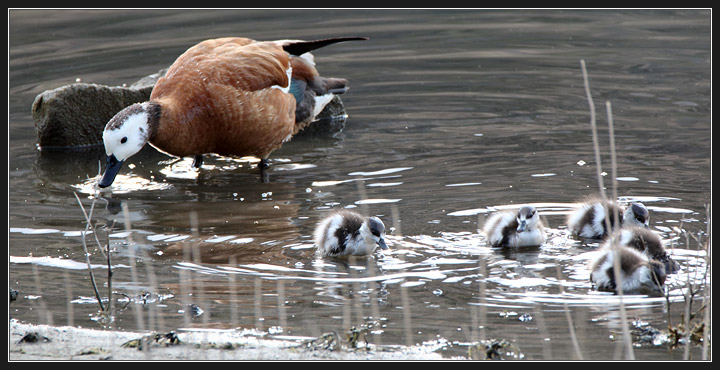 © PJL
© PJL
Mountain Zebra National Park
Links:
Species Text Sabap1
Sabap2
Sasol
 © Flutterby
© FlutterbyMale
 © Toko
© TokoMale. Addo Elephant National Park
 © BluTuna
© BluTunaFemale
 © Toko
© TokoMale & female. Addo Elephant National Park
 © PJL
© PJLMountain Zebra National Park
Links:
Species Text Sabap1
Sabap2
Sasol
- nan
- Posts: 26454
- Joined: Thu May 31, 2012 9:41 pm
- Country: Switzerland
- Location: Central Europe
- Contact:
African Pygmy-Goose
114. African Pygmy-Goose Nettaous auritus (Dwerggans)
Order: Anseriformes. Family: Anatidae
Description
Size 30-33 cm. The smallest waterfowl of the region. The orange body, white face and dark green upperparts are diagnostic. In flight the white secondaries are distinctive. Often sits motionless among floating vegetation.
The male has a white face, highly contrasting head markings and vertical black ear-stripe, metallic green back. Bright yellow bill.
Females are smaller, rather grey, dark eye patches. The female's head tends to be more speckled, and lacks the ear-stripe. Bill buff coloured.
Juveniles resemble female. Less distinctly marked.
Distribution
It occurs across sub-Saharan Africa, including southern Africa. Within southern Africa it is locally common in parts of Zimbabwe, northern Botswana, Mozambique, Limpopo Province and KwaZulu-Natal.
Habitat
Prefers freshwater areas with floating vegetation, especially water lilies Nymphaea, occasionally occupying open swamps, farm dams, river pools and estuaries.
Diet
It mainly eats the seed pods and fruit of water-dwelling plants, especially water lilies, using a variety of foraging techniques such as surface feeding and diving.
Breeding
In high quality habitats, males are capable of keeping a harem of females, but in poorer habitats they tend to be monogamous (one female only). Males are also sometimes serially polygynous, forming a bond with one female at a time, moving on to the next one once she has laid eggs. Usually nests in a cavity of a tree, 4-12 m above the ground, but also known to use old Hamerkop nests and on a rotten palm stump. Can also nest in clumps of sedges or among rocks. The nest is usually near water but can be up to 2 km away. Females compete for nest sites, resorting to fighting one another if necessary. The nest itself consists of a bowl of down. Egg-laying season is from September to April. The female usually lays 8-11 eggs (probably one egg per day) and on completion of the clutch, incubates them for 28-30 days. Clutches of up to 20 are probably due to more than one female laying in the nest. When the female leaves the nest to feed she covers the eggs with down, which keeps them warm. Ducklings have very sharp claws and are able to climb vertical wooden surfaces. They jump from the nest when the female calls them from below the nest. Only the female looks after the young although the male is in the vicinity to drive off intruding males. By 65-70 days the young have fully developed flight feathers.
Call
Soft twittering 2-note calls: cho-choo or pee-wee.
Listen to Bird Call
Status
Locally common resident; listed as Near-threatened.
Order: Anseriformes. Family: Anatidae
Description
Size 30-33 cm. The smallest waterfowl of the region. The orange body, white face and dark green upperparts are diagnostic. In flight the white secondaries are distinctive. Often sits motionless among floating vegetation.
The male has a white face, highly contrasting head markings and vertical black ear-stripe, metallic green back. Bright yellow bill.
Females are smaller, rather grey, dark eye patches. The female's head tends to be more speckled, and lacks the ear-stripe. Bill buff coloured.
Juveniles resemble female. Less distinctly marked.
Distribution
It occurs across sub-Saharan Africa, including southern Africa. Within southern Africa it is locally common in parts of Zimbabwe, northern Botswana, Mozambique, Limpopo Province and KwaZulu-Natal.
Habitat
Prefers freshwater areas with floating vegetation, especially water lilies Nymphaea, occasionally occupying open swamps, farm dams, river pools and estuaries.
Diet
It mainly eats the seed pods and fruit of water-dwelling plants, especially water lilies, using a variety of foraging techniques such as surface feeding and diving.
Breeding
In high quality habitats, males are capable of keeping a harem of females, but in poorer habitats they tend to be monogamous (one female only). Males are also sometimes serially polygynous, forming a bond with one female at a time, moving on to the next one once she has laid eggs. Usually nests in a cavity of a tree, 4-12 m above the ground, but also known to use old Hamerkop nests and on a rotten palm stump. Can also nest in clumps of sedges or among rocks. The nest is usually near water but can be up to 2 km away. Females compete for nest sites, resorting to fighting one another if necessary. The nest itself consists of a bowl of down. Egg-laying season is from September to April. The female usually lays 8-11 eggs (probably one egg per day) and on completion of the clutch, incubates them for 28-30 days. Clutches of up to 20 are probably due to more than one female laying in the nest. When the female leaves the nest to feed she covers the eggs with down, which keeps them warm. Ducklings have very sharp claws and are able to climb vertical wooden surfaces. They jump from the nest when the female calls them from below the nest. Only the female looks after the young although the male is in the vicinity to drive off intruding males. By 65-70 days the young have fully developed flight feathers.
Call
Soft twittering 2-note calls: cho-choo or pee-wee.
Listen to Bird Call
Status
Locally common resident; listed as Near-threatened.
- nan
- Posts: 26454
- Joined: Thu May 31, 2012 9:41 pm
- Country: Switzerland
- Location: Central Europe
- Contact:
African Pygmy-Goose Photos
114. African Pygmy-Goose Nettaous auritus
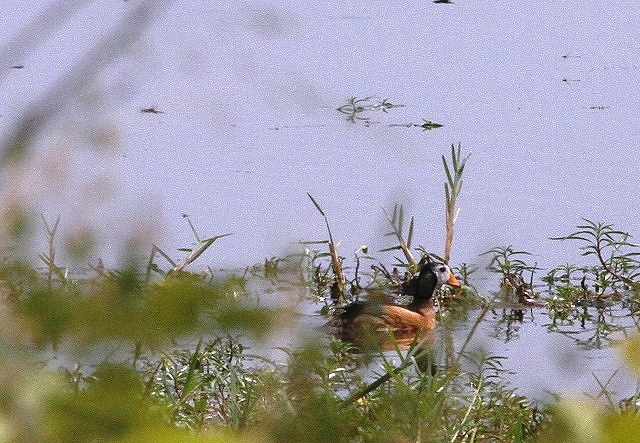 © nan
© nan
Male
 © nan
© nan
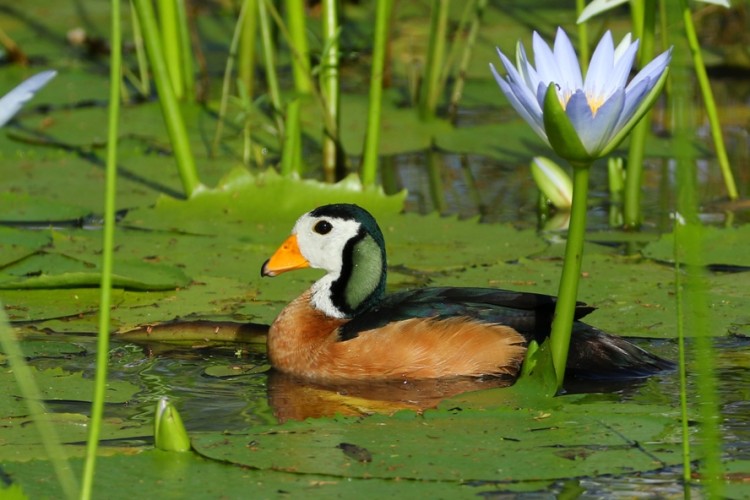 © Dindingwe
© Dindingwe
Mkuze
Links:
Species text Sabap1
Sabap2
 © nan
© nanMale
 © nan
© nanMkuze
Links:
Species text Sabap1
Sabap2
- Lisbeth
- Site Admin
- Posts: 65591
- Joined: Sat May 19, 2012 12:31 pm
- Country: Switzerland
- Location: Lugano
- Contact:
Yellow-billed Duck
104. Yellow-billed Duck Anas undulata (Geelbekeend)
Order: Anseriformes. Family: Anatidae
Description
51-58 cm. The feathers brown, edged with white, with a darker head. They have whitish underwings and white-bordered emerald speculums, a distinctive wing patch on the upper wings. The rich yellow bill with the black saddle on the upper mandible is distinctive. Males and females look alike.
Juveniles are slightly duller than adults.
Similar species: It may be confused with the African Black Duck at a distance but never appears as dark as that.
Distribution
Found mainly in South Africa, where it is very common. It also occurs in patches of Botswana, Namibia and Zimbabwe, although it is hard to find in these areas.

Habitat
Virtually any area of open fresh water: still waters of streams, lakes, swamps, pans, swamps, marshes and sewerage ponds. But largely absent from fast-flowing waters.
Movements
Nomadic, moving between different wetlands and vleis. It rarely travels long distances, although individuals have been recorded to move more than 1000 km.
Diet
It feeds mainly on plants, supplemented with animals.
Breeding
It is a monogamous, solitary nester. It has a very complex courtship display, involving fighting, preening, synchronized swimming, acrobatic flight and strange calls. The pair bond is very short, breaking before the chicks have hatched. The female builds the nest, which is a shallow depression in the ground, lined with fine grass or weeds. It is usually placed in dense cover, never more than 20 m away from water. Egg-laying season is year-round. It lays 2-10 eggs at daily intervals. Incubation is done solely by the female for 26-29 days. She will sometimes leave the nest for short periods, covering the eggs with a scrap of nest lining. The chicks are closely cared for by their mother for their first three weeks of their lives. They usually have their first flight at 68 days, but they remain with their mother for 6 weeks after fledging, after which they become fully independent.
Call
Male quacks like domestic duck. Female mostly silent, gives low whistles. Listen to Bird Call.
Status
Common resident.
Order: Anseriformes. Family: Anatidae
Description
51-58 cm. The feathers brown, edged with white, with a darker head. They have whitish underwings and white-bordered emerald speculums, a distinctive wing patch on the upper wings. The rich yellow bill with the black saddle on the upper mandible is distinctive. Males and females look alike.
Juveniles are slightly duller than adults.
Similar species: It may be confused with the African Black Duck at a distance but never appears as dark as that.
Distribution
Found mainly in South Africa, where it is very common. It also occurs in patches of Botswana, Namibia and Zimbabwe, although it is hard to find in these areas.

Habitat
Virtually any area of open fresh water: still waters of streams, lakes, swamps, pans, swamps, marshes and sewerage ponds. But largely absent from fast-flowing waters.
Movements
Nomadic, moving between different wetlands and vleis. It rarely travels long distances, although individuals have been recorded to move more than 1000 km.
Diet
It feeds mainly on plants, supplemented with animals.
Breeding
It is a monogamous, solitary nester. It has a very complex courtship display, involving fighting, preening, synchronized swimming, acrobatic flight and strange calls. The pair bond is very short, breaking before the chicks have hatched. The female builds the nest, which is a shallow depression in the ground, lined with fine grass or weeds. It is usually placed in dense cover, never more than 20 m away from water. Egg-laying season is year-round. It lays 2-10 eggs at daily intervals. Incubation is done solely by the female for 26-29 days. She will sometimes leave the nest for short periods, covering the eggs with a scrap of nest lining. The chicks are closely cared for by their mother for their first three weeks of their lives. They usually have their first flight at 68 days, but they remain with their mother for 6 weeks after fledging, after which they become fully independent.
Call
Male quacks like domestic duck. Female mostly silent, gives low whistles. Listen to Bird Call.
Status
Common resident.
- Lisbeth
- Site Admin
- Posts: 65591
- Joined: Sat May 19, 2012 12:31 pm
- Country: Switzerland
- Location: Lugano
- Contact:
Yellow-billed Duck Photos
104. Yellow-billed Duck Anas undulata
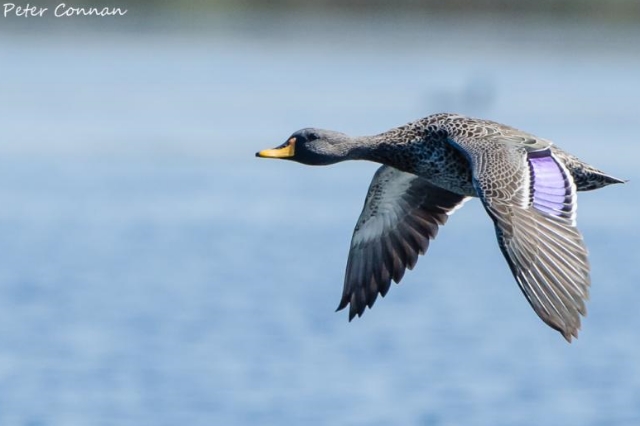 © Peter Connan
© Peter Connan
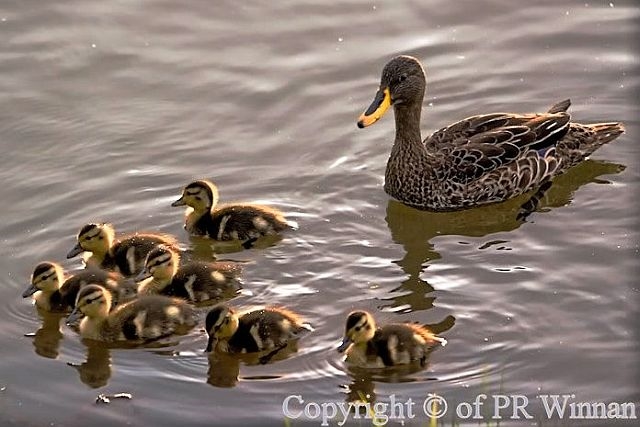 © PRWIN
© PRWIN
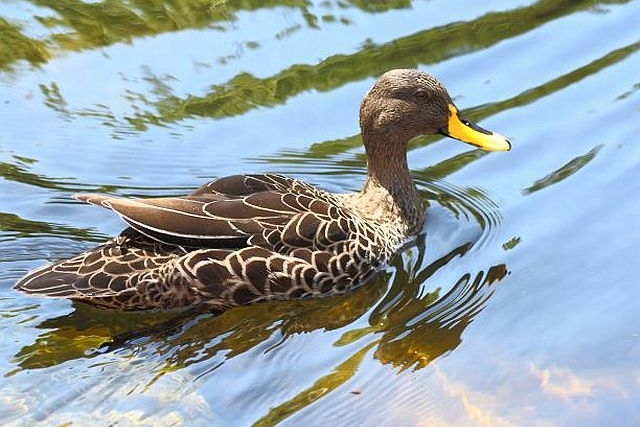 © Flutterby
© Flutterby
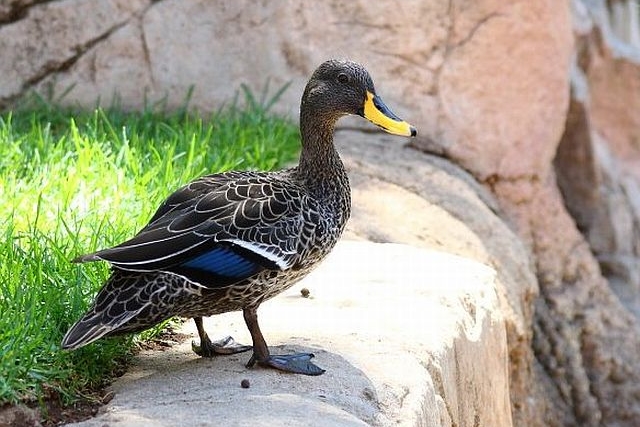 © Flutterby
© Flutterby
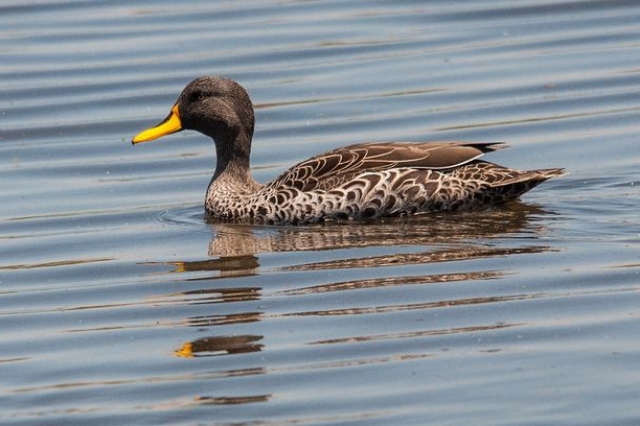 © steamtrainfan
© steamtrainfan
Marievale, Gauteng
 © Duke
© Duke
Marievale, Gauteng
Links:
Species text in The Atlas of Southern African Birds: http://sabap2.adu.org.za/docs/sabap1/104.pdf
Sabap2: http://sabap2.adu.org.za/species_info.p ... #menu_left
Wildfowl
 © Peter Connan
© Peter Connan © PRWIN
© PRWIN © Flutterby
© Flutterby © Flutterby
© Flutterby © steamtrainfan
© steamtrainfanMarievale, Gauteng
 © Duke
© DukeMarievale, Gauteng
Links:
Species text in The Atlas of Southern African Birds: http://sabap2.adu.org.za/docs/sabap1/104.pdf
Sabap2: http://sabap2.adu.org.za/species_info.p ... #menu_left
Wildfowl
- Flutterby
- Posts: 44029
- Joined: Sat May 19, 2012 12:28 pm
- Country: South Africa
- Location: Gauteng, South Africa
- Contact:
African Black Duck
105. African Black Duck Anas sparsa (Swarteend)
Order: Anseriformes. Family: Anatidae
Description
A dark-billed, dark-plumaged duck with white speckles on the back, bright orange legs and feet, and a blue-green speculum edged with white.
Sexes are alike but females are smaller.
Juveniles are paler with a whitish belly.
Distribution
Widespread throughout sub-Saharan Africa. Fairly common in in both South Africa and Zimbabwe, with a very small population in Namibia.
Habitat
It is a habitat specialist found in fast-moving streams and rivers during the day, preferring large open waters at night.
Diet
The diet includes larvae and pupae, aquatic animals, plant material, seeds, small fish, snails, and crabs. It usually feeds by dabbling, filtering or upending.
Breeding
Monogamous, territorial solitary nester. The female builds a cup shaped nest from driftwood and matted grass, lined with down feathers, and the nest is placed near running water. 4-8 eggs are laid in successive mornings and incubated by the female for 30 days. The young are cared for by the female, and fledge after about 80 days.
Call
Loud quack by female. Male gives wheezy peep.
Listen to Bird Call.
Status
Widespread resident.
Order: Anseriformes. Family: Anatidae
Description
A dark-billed, dark-plumaged duck with white speckles on the back, bright orange legs and feet, and a blue-green speculum edged with white.
Sexes are alike but females are smaller.
Juveniles are paler with a whitish belly.
Distribution
Widespread throughout sub-Saharan Africa. Fairly common in in both South Africa and Zimbabwe, with a very small population in Namibia.
Habitat
It is a habitat specialist found in fast-moving streams and rivers during the day, preferring large open waters at night.
Diet
The diet includes larvae and pupae, aquatic animals, plant material, seeds, small fish, snails, and crabs. It usually feeds by dabbling, filtering or upending.
Breeding
Monogamous, territorial solitary nester. The female builds a cup shaped nest from driftwood and matted grass, lined with down feathers, and the nest is placed near running water. 4-8 eggs are laid in successive mornings and incubated by the female for 30 days. The young are cared for by the female, and fledge after about 80 days.
Call
Loud quack by female. Male gives wheezy peep.
Listen to Bird Call.
Status
Widespread resident.
- Flutterby
- Posts: 44029
- Joined: Sat May 19, 2012 12:28 pm
- Country: South Africa
- Location: Gauteng, South Africa
- Contact:
African Black Duck Photos
105. African Black Duck Anas sparsa
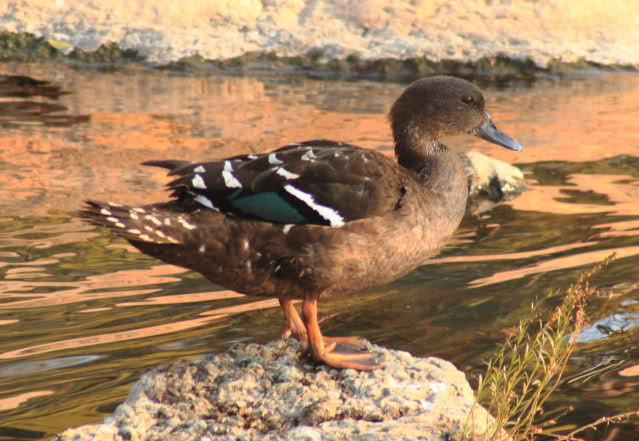
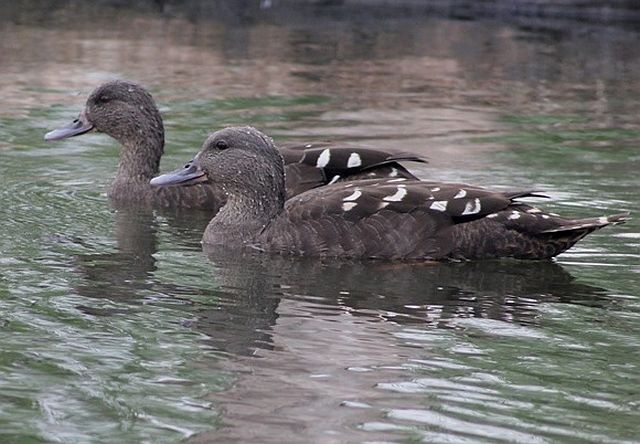 © Amoli
© Amoli
Rietvlei Nature Reserve, Gauteng
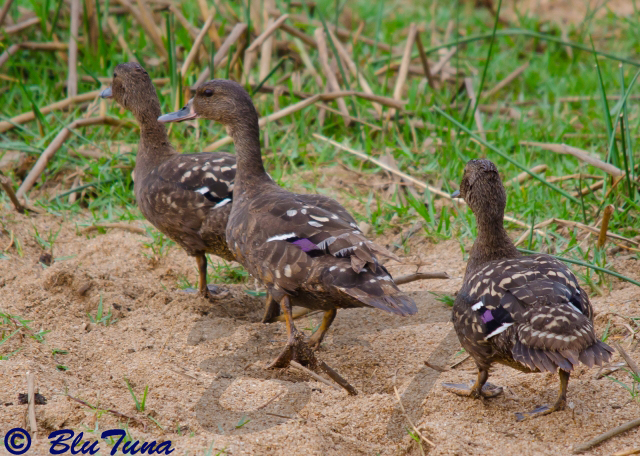 © BluTuna
© BluTuna
Kruger National Park
Links:
Species text Sabap1
Sabap2

 © Amoli
© AmoliRietvlei Nature Reserve, Gauteng
 © BluTuna
© BluTunaKruger National Park
Links:
Species text Sabap1
Sabap2


